Who Run the (Natural) World: Girls
Happy Women’s History Month! While I’m in awe of women every single day, I’m grateful for a designated month to reflect on the countless contributions women have made to move our world forward, often while having to juggle and overcome a litany of social pressures and limitations.
When thinking of quintessential conservation heroes, a lot of distinctly male names come to mind: Charles Darwin, Teddy Roosevelt, John Muir, and John James Audubon, to name a few. But women have certainly made their mark on the conservation field, from early wildlife pioneers like Rosalie Edge to iconic 20th-century activists like Jane Goodall. In honor of Women’s History Month, here are 10 female conservation heroes, some who altered the history of the field and others redefining what’s possible for the future.

Florence Merriam Bailey (1863 – 1948)
Florence Merriam Bailey was one of the first nationally recognized female ornithologists in American history. Fascinated with birds from an early age, Bailey led Audubon birdwatching tours and published in Audubon Magazine while attending Smith College. Bailey was also a devoted educator, especially to the working classes, and established ornithological programs at Hull House and other settlement houses. Bailey was renowned for her talent for illustrative writing, and published a number of highly successful birding guides and ornithological textbooks. Her work was a marked departure from other ornithological works, which studied trapped birds in indoor settings, rather than focusing on the natural, outdoor study of live birds. She was also pivotal in passing the Lacey Act of 1900, which prohibited the trade of wild animals that had been illegally killed.
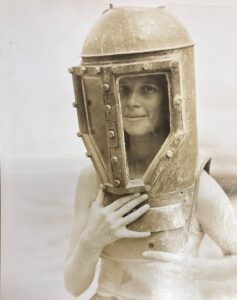 Gloria Hollister Anable (1900-1988)
Gloria Hollister Anable (1900-1988)
Gloria Hollister Anable was an accomplished scientist, explorer, and conservationist specializing in fish osteology (the scientific and anatomical study of bones). Anable was one of the first female scientists to join Department of Tropical Research (DTR), despite pushback concerning the capabilities of female scientists. While in the Caribbean with the DTR in the late 1930s, Anable significantly extended scientific knowledge about deep sea and reef fish and set the world record for deepest dive undertaken by a woman. After establishing the world’s first Red Cross blood bank during World War II, Anable led efforts to protect old-growth forest along southwest New York’s Mianus River, which eventually led to the establishment of the Nature Conservancy, currently one of the world’s foremost conservation organizations.

Mardy Murie (1902 – 2003)
Often referred to as “the grandmother of the conservation movement,” Margaret “Mardy” Murie was a key figure in passing the Wilderness Act (1964) and establishing the Arctic National Wildlife Refuge. Murie’s research in the Alaskan wilderness in the 1920s and her belief in preserving entire ecosystems laid the intellectual foundation for large parks and preserves. In addition to her work in Alaska, Murie worked in Tanzania and New Zealand studying and protecting wild areas. Murie received the Audubon Medal in 1980, the John Muir Award in 1983, and the Presidential Medal of Freedom in 1998. She died in 2003 at 101 years old.
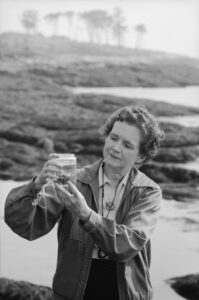 Rachel Carson (1907-1964)
Rachel Carson (1907-1964)
Famed marine biologist and nature writer Rachel Carson is best known for publishing Silent Spring (1962), an environmentalist work examining the negative effects of pesticides, which led to a nationwide ban of DDT. Silent Sprint catalyzed the emerging environmentalist movement that sparked the creation of the U.S. Environmental Protection Agency (EPA). Prior to the publication of Silent Spring, Carson was the second woman in history to be hired by the U.S. Bureau of Fisheries where she worked for 15 years before being promoted to Editor-in-Chief of all publications for the U.S. Fish and Wildlife Service. Carson received medals from the National Audubon Society and the American Geographical Society, an induction into the American Academy of Arts and Letters, and was posthumously awarded the Presidential Medal of Freedom in 1980.
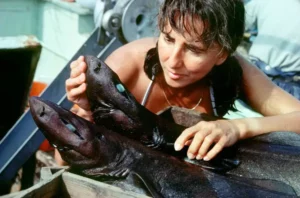 Eugenie Clark (1922-2015)
Eugenie Clark (1922-2015)
Known as “The Shark Lady,” Dr. Eugenie Clark was an influential marine biologist who worked tirelessly to change the public perception of sharks. Born to an American father and Japanese mother, Clark faced prejudice on multiple levels trying to break into the male-dominated marine biology field after World War II. After being rejected from Columbia University out of fear that she would eventually leave her scientific career to focus on raising children, Clark went on to earn both a Master of Arts (1946) and Doctorate of Zoology (1950) from New York University. As a Fulbright Scholar in the 1950s, Clark conducted research in the largely unexplored waters of the Red Sea, where she discovered several fish species and made significant advancements in the understanding of shark behavior and biology. In 1955, Clark founded the Cape Haze Marine Laboratory in Sarasota, Florida. Known today as the Mote Marine Laboratory and Aquarium, the facility’s research includes fisheries, coral reef restoration, marine mammals, marine biomedicine, and, of course, sharks.
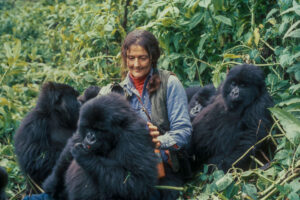 Dian Fossey (1932-1985)
Dian Fossey (1932-1985)
Dr. Dian Fossey was an American primatologist and conservationist known for her extensive study of mountain gorillas. While working as an occupational therapist in the 1950s, Fossey used her life savings to fund a tour through central Africa, where she became fascinated with the study of great apes. Fossey was invited back to Africa in 1966 for an extended period of study living among mountain gorillas in the Democratic Republic of Congo. After civil war broke out in the Congo in 1967, Fossey established the Karisoke Research Center in Rwanda’s Volcanoes National Park where she made notable contributions to gorilla research, including gorilla vocalizations, gorilla diets, and how gorillas recycle nutrients. Fossey was a vocal anti-poaching activist, and after losing a particularly beloved gorilla to poachers, Fossey founded the Dian Fossey Gorilla Fund, Zoo Atlanta’s longtime partner in gorilla conservation and headquartered here on Zoo grounds.
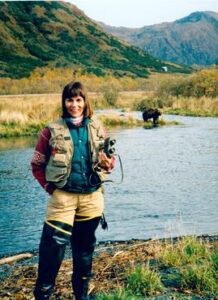 Mollie H. Beattie (1947-1996)
Mollie H. Beattie (1947-1996)
Mollie Beattie was the first female director of the U.S. Fish and Wildlife Services. Beattie worked as commissioner of Vermont’s Forests and Parks before becoming the deputy secretary of Vermont’s Agency of Natural Resources in 1990. During her tenure as director of Fish and Wildlife Services (1993-1996), Beattie worked to implement over 100 wildlife conservation plans, collaborated on creating 15 different wildlife refuges across the country, and was essential in the successful reintroduction of the grey wolf to the northern Rocky Mountains. She was also an advocate for conservation legislation, and was a particularly fervent champion of the Endangered Species Act. Following her death in 1996, Congress changed the name of Alaska’s Arctic National Wildlife Refuge to the Mollie Beattie Wilderness.
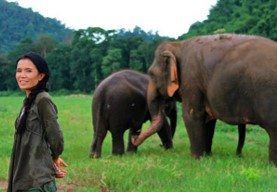 Saengduean “Lek” Chailert (1961-)
Saengduean “Lek” Chailert (1961-)
Called Thailand’s “Elephant Whisperer,” Saengduean “Lek” Chailert worked in tourism in northern Thailand as a postgraduate, where she was deeply affected by the mistreatment and suffering of Asian elephants in the industry. In the 1990’s, Chailert started rescuing injured, neglected, and elderly elephants, and established Elephant Nature Park in 2003, an elephant rescue and rehabilitation center in Chiang Mai, Thailand. Chailert is also the founder of Save Elephant Foundation, a Thai non-profit organization dedicated to providing care and assistance to Thailand’s elephant population. Chailert has received many awards for her extensive rescue and conservation efforts, including the French Legion of Honor.
 Paula Kahumbu (1966-)
Paula Kahumbu (1966-)
Dr. Paula Kahumbu is a wildlife conservationist and CEO of WildlifeDirect, a non-profit that amplifies the voices of African conservationists. A Nairobi native, Kahumbu is best known for spearheading the Hands Off Our Elephants Campaign in partnership with Margaret Kenyatta, the First Lady of the Republic of Kenya. Hands Off Our Elephants partners with civil societies, corporations, government agencies, and other conservation organizations in the hopes of ending Kenya’s poaching crisis. Since the campaign’s launch, elephant and rhino poaching in Kenya has declined by 80% and 90% respectively. Kahumbu won the National Geographic Buffet Award in 2021 for conservation leadership in Africa and received a special commendation from the United Nations in 2013, as well as the Kenyan Order of the Grand Warrior in 2014.
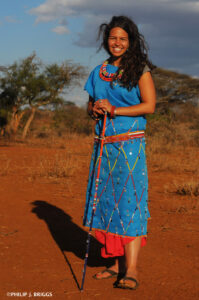 Leela Hazzah (1979-)
Leela Hazzah (1979-)
Born in Egypt, Dr. Leela Hazzah grew up listening to her older relatives tell stories about hearing lions roar from the rooftops of their homes. These stories greatly affected Hazzah, as Barbary (or North African) lions went extinct in the early 20th century, and she was inspired to pursue a career in lion conservation. After earning her doctorate from the University of Wisconsin, Madison, Hazzah lived with the indigenous Mbirikani Maasai along the Kenya-Tanzania border for a year, studying their relationships with lions. Building on the knowledge learned during this time, Hazzah co-founded Lion Guardians with Dr. Stephanie Dolrenry in 2006. Lion Guardians is a community- focused conservation organization that recruits young, traditional Maasai warriors to mitigate conflicts between people and wildlife, monitor lion populations, and help their own communities live with lions. Hazzah currently serves as the Executive Director of Lion Guardians. She was named one of CNN’s “Top ten heroes” of the year in 2014.

Connect With Your Wild Side #onlyzooatl